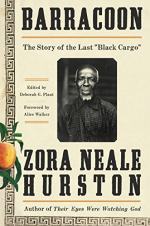|
This section contains 603 words (approx. 2 pages at 400 words per page) |

|
Barracoon Summary & Study Guide Description
Barracoon Summary & Study Guide includes comprehensive information and analysis to help you understand the book. This study guide contains the following sections:
This detailed literature summary also contains Topics for Discussion on Barracoon by Zora Neale Hurston.
In the summer of 1927, Zora Neale Hurston set out from New York City to conduct a series of interviews with Cudjo Lewis, who, in 1859, was the last man captured from Africa and sold into American slavery. Hurston addressed Lewis as Kossula, his African name, and over a series of conversations in Kossula’s home in Plateau, Alabama (originally named Africatown following the U.S. Civil War) Kossula told her about his time growing up in Takkoi, his African homeland; about the violent raiding of his village by the neighboring tribe of Dahomey; about his captivity in a “barracoon,” a prison on the west coast of Africa, where he was eventually sold to an American slaver; his journey across the Atlantic on the Clotilda, the last slave ship believed to have made the journey from Africa to the United States; his five and a half years in captivity as the slave of Jim Meaher in Alabama; and, finally, the series of tragedies that befell him following his emancipation in 1865, including the death of his wife and six children.
Barracoon consists primarily of dialogue from Kossula, which Hurston bravely chose to render in vernacular, writing his speech down exactly as it sounded. Following a preface that offered certain historical and contextual details of Kossula’s life, the chapters consist mainly of Kossula’s memories, often introduced and concluded by brief descriptions from Hurston.
The first several chapters of the book focused on Kossula’s upbringing in Africa and his ancestry. Kossula explained to Hurston that to tell the story of his life, he would have to begin with his forefathers. He explained that he wasn’t born into high rank in his tribe, but that his grandfather had been an officer of the local king. He told Hurston about the way people were benignly ruled by this king, and how justice was always administered in a transparent way. He explained how he was trained in hunting and the ways of war, and how he was on the cusp of full manhood when the warring tribe of Dahomey invaded his village.
Following the violent sacking of Kossula’s village, he was marched two days to Dahomey, and from there was taken to Ouidah and sold to Bill Foster, a white American slaver. After a brutal 70 day journey across the Atlantic ocean, Foster’s ship, the Clotilda, arrived off the coast of Alabama. Kossula became the property of Jim Meaher, a plantation owner, and for five and a half years he loaded and unloaded a riverboat on its rounds from Mobile to Montgomery, Alabama, in his capacity as slave.
After hearing news of the Civil War’s conclusion and his emancipation, Kossula and other newly freed slaves banded together and formed Africatown, having saved enough money from menial, low-wage jobs to buy a plot of land from Jim Meaher and his brothers. There, Kossula was married and raised a family, but not without great hardship. He lost several children to illness and was struck by a train, rendering him incapable of working (after which time Kossula became a sexton of the local Baptist church). One of his sons was shot and killed by a local law enforcement official without cause; another disappeared without a trace. Finally, Kossula’s wife died and left him entirely alone in his home. He relayed these dramatic events to Hurston over the series of many conversations, during which they shared food and formed a friendship. She, in turn, listened attentively, took his photograph, and contemplated his experience as a man “full of trembling awe before the altar of the past” (94).
Read more from the Study Guide
|
This section contains 603 words (approx. 2 pages at 400 words per page) |

|



